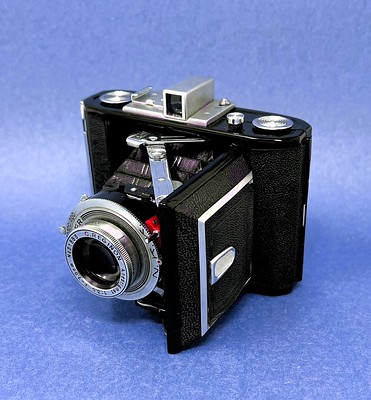Difference between revisions of "Semi Leotax DL and R"
Rebollo fr (talk | contribs) (dropped contents from the page on the Semi Leotax) |
(image added) |
||
| (112 intermediate revisions by 5 users not shown) | |||
| Line 1: | Line 1: | ||
| + | {{Japanese Semi postwar | ||
| + | |image=[https://www.flickr.com/photos/140327438@N08/53338900582/in/pool-camerawiki https://live.staticflickr.com/65535/53338900582_57b7d79381_w_d.jpg]<br>''image by {{image by|Randy Kroll}}. {{with permission}}'' | ||
| + | }} | ||
| + | The '''Semi Leotax DL''' (セミレオタックスDL型) and '''Semi Leotax R''' (セミレオタックスR型) are [[Japanese 4.5×6 folders|Japanese 4.5×6 folding cameras]] made from late 1950 to early 1955 by [[Shōwa Kōgaku]], that was also making the [[Leotax]] Leica copies. The viewfinder-only Semi Leotax DL appeared first, to replace the previous [[Semi Leotax]] with folding finder. The Semi Leotax R was introduced later, as a more expensive alternative with an uncoupled rangefinder. | ||
| − | == | + | == General description == |
| − | === Description and early | + | The Semi Leotax DL and R are vertical folding cameras. The body casting is certainly the same as on the previous [[Semi Leotax]]. The three-part folding struts are different, and are now copied on the [[Ikonta]], whereas the previous model was a copy of the [[Nettar]]. The folding bed has a chrome frame and no bulge for the lens, unlike the previous model. |
| − | {| class="plainlinks" align="center" style="text-align: center; | + | |
| + | The film is advanced by a key at the bottom right, as seen by the photographer holding the camera horizontally. The back is hinged to the left, and locked by a sliding bar on the right. It contains a single red window at the bottom left, protected by a vertically sliding cover, similar to that found on the late examples of the previous [[Semi Leotax]]. The shutter release is at the top left, close to the front hinge. The front door is opened by a button placed under the camera, next to the advance key, and there is a ¼-inch tripod thread on the opposite side. | ||
| + | |||
| + | The name ''SEMI LEOTAX'' is embossed in slanted capital letters on the artificial leather covering at the front. The rectangular ''S.O.W'' logo of [[Shōwa Kōgaku]] (for <U>S</U>howa <U>O</U>ptical <U>W</U>orks) is embossed on the back, and engraved in the folding struts. | ||
| + | |||
| + | The shutter has a self-timer and is synchronized for flash on all the cameras, and the range of speeds is either B, 1–200, or B, 1–300 (on most examples of the model R). The lens is a 7.5cm f/3.5, focused by turning the front cell, supplied by different manufacturers. The lens types are the Toko, Kominar and Reginon or S-Reginon, all of which are presumed to have three elements.<REF> This is certain for the Toko, a brand name which was used by [[Tōkyō Kōgaku]] for three-element designs only. The S-Reginon is reported to have three elements in [https://web.archive.org/web/20120325100617/http://homepage.mac.com/orio/camera/Semi_Leotax/Semi_Leotax.html this page] at [https://web.archive.org/web/20120325095216/http://homepage.mac.com/orio/index.html Orio's Modern Classic Cameras] (archived), by someone who disassembled one. The Kominar lens was priced roughly the same, and certainly has three elements too. </REF> At the time, the Toko lens was the most expensive and the Reginon was the cheapest. | ||
| + | {{br}} | ||
| + | |||
| + | == Early announce == | ||
| + | {{Flickr_image | ||
| + | |image_source= https://www.flickr.com/photos/camerawiki/50067850477/in/pool-camerawiki/ | ||
| + | |image= https://live.staticflickr.com/65535/50067850477_06e35553d5_n.jpg | ||
| + | |image_align= right | ||
| + | |image_text= Semi Leotax with Olympus Yoko Lens | ||
| + | |image_by= Eddie Jan | ||
| + | |image_rights= with permission | ||
| + | }} | ||
| + | The camera was first announced under the name "New Semi Leotax" in the December 1950 issue of {{ACA}}. The new model is described both in the news column and in the advertisement placed by [[Shōwa Kōgaku]], which nonetheless shows a picture of the former [[Semi Leotax]].<REF> Advertisement reproduced in {{Kokusan}}, p.211. The contents of the news column is summarized in the same book, p.374 (item 1036). </REF> | ||
| + | |||
| + | The description mentions three-part folding struts, a flat folding bed with a chrome frame, and a chrome top cover containing the viewfinder and an uncoupled rangefinder. The latter feature would only appear 18 months later on the Semi Leotax R, but was already planned at that period. | ||
| + | |||
| + | In both the advertisement and the news column, the shutter is announced as a [[Copal]] (B, 1–200) and the lens as a "Yōkō" (ヨーコー) 75/3.5 made by [[Olympus]]. This lens name is otherwise unknown, but photos of an actual Semi-Leotax with a lens named "[[Olympus]] Yoko" have since then appeared. It might be a renamed Olympus-made [[Zuiko]] (ズイコー) lens<ref>Might need further confirmation as it was unusual for Olympus to name a lens otherwise then Zuiko.</ref>. | ||
| + | |||
| + | The actual camera was released as the '''Semi Leotax New''' (セミレオタックス新型) in early 1951 before it was gradually renamed '''Semi Leotax DL''' (セミレオタックスDL型) in mid to late 1952, with no apparent reason. It has all the features announced but for the rangefinder and the lens and shutter equipment. | ||
| + | |||
| + | == Semi Leotax DL, with tubular finder == | ||
| + | === Description === | ||
| + | The Semi Leotax DL has a tubular finder, mounted on a rectangular metal plate which also holds the accessory shoe on the right. The rear of the finder is moved up and down for parallax correction by sliding a button placed on the left, from the infinity position to the close distance position, either ''3.5'' or ''4'' (expressed in feet). The release button is surrounded by a cup and has a screw-thread to attach a distant-release connector. There are flanges at both ends of the top part, which can be lifted to insert the film spools. The shutter always has 1/200 top speed. | ||
| + | |||
| + | {| class="plainlinks" align="center" style="text-align: center;" | ||
| + | |- | ||
| + | || [http://www.flickr.com/photos/camerawiki/47264014531/in/pool-camerawiki http://farm8.staticflickr.com/7819/47264014531_1e89dd58a1_m_d.jpg] [http://www.flickr.com/photos/camerawiki/46540558954/in/pool-camerawiki http://farm8.staticflickr.com/7910/46540558954_bc0bb0727b_m_d.jpg] [http://www.flickr.com/photos/camerawiki/46540577694/in/pool-camerawiki http://farm8.staticflickr.com/7876/46540577694_18f261892e_m_d.jpg] | ||
| + | |- | ||
| + | || [http://www.flickr.com/photos/camerawiki/33388339728/in/pool-camerawiki http://farm8.staticflickr.com/7914/33388339728_5d1e3a6247_t_d.jpg] [http://www.flickr.com/photos/camerawiki/40299430063/in/pool-camerawiki http://farm8.staticflickr.com/7813/40299430063_a02efec447_t_d.jpg] [http://www.flickr.com/photos/camerawiki/46349587205/in/pool-camerawiki http://farm8.staticflickr.com/7851/46349587205_fbd6650d56_t_d.jpg] [http://www.flickr.com/photos/camerawiki/40299456453/in/pool-camerawiki http://farm8.staticflickr.com/7916/40299456453_3dfaf182a8_t_d.jpg] [http://www.flickr.com/photos/camerawiki/46349621665/in/pool-camerawiki http://farm8.staticflickr.com/7835/46349621665_486fdd35b3_t_d.jpg] [http://www.flickr.com/photos/camerawiki/46349644625/in/pool-camerawiki http://farm8.staticflickr.com/7807/46349644625_8e48509e1b_t_d.jpg] [http://www.flickr.com/photos/camerawiki/47212371122/in/pool-camerawiki http://farm8.staticflickr.com/7927/47212371122_3acca0aa53_t_d.jpg] | ||
| + | |- | ||
| + | || ''Semi Leotax DL, S. Reginon 7.5cm f/3.5 lens no.1801, [[Nishida shutters|N.K.K. Wester]] shutter (B, 1–200), synch pin, early advance key.''<br>''Pictures courtesy of eBayer Costellochris. {{with permission}}'' | ||
| + | |} | ||
| + | |||
| + | === Documents === | ||
| + | The earliest advertisement actually showing the camera is reportedly dated January 1951.<REF> {{Kokusan}}, p.374. </REF> The August 1951 advertisement in {{ACA}} gives no price, and mentioned a Reginon or Kominar 75/3.5 lens and a [[Nishida shutters|Wester]] or [[Copal]] shutter (B, 1–200).<REF> Advertisement reproduced in {{Kokusan}}, p.211. </REF> | ||
| + | |||
| + | {| class="plainlinks" align="center" style="text-align: center;" | ||
| + | || [http://www.flickr.com/photos/camerawiki/47214097162/in/pool-camerawiki http://farm8.staticflickr.com/7862/47214097162_9a750fc11e_d.jpg] | ||
| + | |- | ||
| + | || ''Advertisement in {{SK}} November 1952. {{public domain Japan new}}'' | ||
| + | |} | ||
| + | The earliest document mentioning the name "Semi Leotax DL" is an advertisement dated May 1952.<REF> {{Kokusan}, p.374. </REF> That in {{SK}} November 1952, reproduced above, only has the name "Semi Leotax", and lists three lens and shutter combinations:<REF> Advertisement in {{SK}} November 1952, p.11. </REF> | ||
| + | * Toko 7.5cm f/3.5 lens, [[Copal]] shutter, {{yen|14,500|1952}}; | ||
| + | * Kominar 7.5cm f/3.5 lens, [[Copal]] shutter, {{yen|13,500|1952}}; | ||
| + | * Reginon 7.5cm f/3.5 lens, [[Nishida shutters|Wester]] shutter, {{yen|12,500|1952}}. | ||
| + | The Toko was supplied by [[Tōkyō Kōgaku]] and the Kominar by [[Nittō Kōgaku]]. The maker of the Reginon is unknown; it might be [[Nishida]], which made the Wester shutter, and supplied Wester Anastigmat lenses for the early postwar [[Semi Leotax]] just before the introduction of the Reginon lens brand. | ||
| + | |||
| + | Advertisements dated January 1953 in {{ACA}}<REF> Advertisement reproduced in {{Kokusan}}, p.212. </REF> and {{SK}}<REF name="SK 01/53"> Advertisement in {{SK}} January 1953, p.24. The price of the version with Kominar and Copal is mentioned as ¥13,000, perhaps a misprint. </REF> mostly convey the same information, and show a picture of the newly released Semi Leotax R (see below). | ||
| + | |||
| + | {| class="plainlinks" align="center" style="text-align: center;" | ||
| + | || [http://www.flickr.com/photos/camerawiki/33390186798/in/pool-camerawiki http://farm8.staticflickr.com/7804/33390186798_3bf7fd70ca_d.jpg] | ||
|- | |- | ||
| − | || [http://www.flickr.com/photos/ | + | || ''Advertisement in {{SK}} July 1953. {{public domain Japan new}}'' |
| + | |} | ||
| + | |||
| + | The advertisement in {{SK}} July 1953, reproduced above, mentions a New Trio shutter in addition to the [[Copal]] and [[Nishida shutters|Wester]], and lists the usual Toko, Kominar and Reginon lenses.<REF> Advertisement in {{SK}} July 1953, p.18. </REF> The maker of the New Trio is unknown, though actual examples show the initials [[IJK|I.J.K.]], also found on the shutter of a few [[Tougodo]] cameras. | ||
| + | |||
| + | {| class="plainlinks" align="center" style="text-align: center;" | ||
| + | || [http://www.flickr.com/photos/camerawiki/47214139882/in/pool-camerawiki http://farm8.staticflickr.com/7910/47214139882_d9e3c25a43_m_d.jpg] [http://www.flickr.com/photos/camerawiki/47214155262/in/pool-camerawiki http://farm8.staticflickr.com/7850/47214155262_4ffe1f959c_m_d.jpg] [http://www.flickr.com/photos/camerawiki/46542643544/in/pool-camerawiki http://farm8.staticflickr.com/7841/46542643544_a437ff1a69_m_d.jpg] | ||
|- | |- | ||
| − | || | + | || ''Advertisements in {{ACA}} September to November 1953. {{public domain Japan new}}'' |
| + | |} | ||
| + | The version with New Trio shutter is pictured in the advertisements in {{ACA}} dated September to November 1953, reproduced above.<REF> Advertisements in {{ACA}} dated September 1953 (p.3), October 1953 (p.3) and November 1953 (p.3). </REF> The camera has the late type of advance key (see below). | ||
| + | |||
| + | {| class="plainlinks" align="center" style="text-align: center;" | ||
| + | || [http://www.flickr.com/photos/camerawiki/47223744082/in/pool-camerawiki http://farm8.staticflickr.com/7850/47223744082_e27e619981_d.jpg] [http://www.flickr.com/photos/camerawiki/40311258443/in/pool-camerawiki http://farm8.staticflickr.com/7806/40311258443_546a42fd6e_d.jpg] | ||
|- | |- | ||
| − | || ''Semi Leotax | + | || ''Semi Leotax DL in a leaflet by Shōwa Kōgaku, c.1953. {{public domain Japan new}}'' |
|} | |} | ||
| − | + | The leaflet reproduced above is dated 1953 or perhaps earlier. It shows the Semi Leotax DL along with the Leotax rangefinder camera. The document describes the usual lens and shutter equipment; the New Trio is not mentioned, and the price is not given. | |
| − | + | === Evolution === | |
| + | {| class="plainlinks" align="center" style="text-align: center;" | ||
| + | |- | ||
| + | || [http://www.flickr.com/photos/camerawiki/46361400425/in/pool-camerawiki http://farm8.staticflickr.com/7814/46361400425_a7115cc2a4_m_d.jpg] [http://www.flickr.com/photos/camerawiki/33400150408/in/pool-camerawiki http://farm8.staticflickr.com/7830/33400150408_c2b9189bc2_m_d.jpg] [http://www.flickr.com/photos/camerawiki/46361432495/in/pool-camerawiki http://farm8.staticflickr.com/7848/46361432495_920f155c29_m_d.jpg] | ||
| + | |- | ||
| + | || [http://www.flickr.com/photos/camerawiki/46552618724/in/pool-camerawiki http://farm8.staticflickr.com/7890/46552618724_5e1c60191e_t_d.jpg] [http://www.flickr.com/photos/camerawiki/32333987537/in/pool-camerawiki http://farm8.staticflickr.com/7804/32333987537_d5e6a026a1_t_d.jpg] [http://www.flickr.com/photos/camerawiki/33400225188/in/pool-camerawiki http://farm8.staticflickr.com/7892/33400225188_26a3ec0f58_t_d.jpg] | ||
| + | |- | ||
| + | || ''Semi Leotax DL, Toko 7.5cm f/3.5 lens no.110xxx, Copal shutter (B, 1–200), ASA synch post, early advance key.''<br>''Pictures courtesy of eBayer Jsahm. {{with permission}}'' | ||
| + | |} | ||
| + | The Semi Leotax DL evolved little during the production run. The '''early cameras''' have the same type of advance key as the previous [[Semi Leotax]].<REF> Examples with Kominar lens in the 21xxx to 23xxx range, with the Toko lens in the 110xxx and 111xxx range, with Reginon lens in the 35xxx to 38xxx range and S-Reginon lens in the 1xxx to 5xxx range. </REF> The minimum distance is marked as ''3.5'' on the viewfinder side, and presumably corresponds to 3.5ft minimum setting on the lens rim. | ||
| − | The | + | The lens and shutter combinations observed on those examples are the Reginon and Wester, Toko and Copal, Kominar and Copal. The [[Nishida shutters|Wester]] shutters used at the period have the brand name ''WESTER'' at the top of the front plate, the maker's initials ''N.K.K.'' on the speed rim, and a single synch pin at the bottom right (as seen from the front). The corresponding Reginon lenses have the name inscribed on a black bezel as ''C.REGINON'' (with a red ''C.'') for the earliest ones, and later plain ''REGINON''. They have a five-digit number in the 35xxx to 38xxx range, and the removal of the red ''C.'' occurred in the 358xx or 359xx range.<REF> Examples with C.Reginon observed in [http://minorhouse.cocolog-nifty.com/blog/2007/07/post_2a32.html this page at Minor House] and in an online auction. Examples with Reginon observed in various posts [http://junkcamera.blog9.fc2.com/blog-entry-199.html][http://junkcamera.blog9.fc2.com/blog-entry-389.html] at Junk Binbō, and in online auctions. </REF> |
| − | + | {| class="plainlinks floatright" width=250px style="text-align: center;" | |
| + | || [http://www.flickr.com/photos/camerawiki/46540577694/in/pool-camerawiki http://farm8.staticflickr.com/7876/46540577694_18f261892e_m_d.jpg] | ||
| + | |- | ||
| + | || ''S. Reginon 7.5cm f/3.5 lens no.1801, [[Nishida shutters|Wester]] shutter, synch pin. Picture by eBayer Costellochris. {{with permission}}'' | ||
| + | |} | ||
| + | The [[Copal]] shutters have a white front plate and an ASA synch post at the top right. The Kominar lenses used in the period have a chrome bezel and a five-digit number in the 21xxx to 23xxx range. The Toko lenses have a similar chrome bezel and a six-digit number in the 110xxx to 111xxx range, such as the camera pictured above. | ||
| − | + | At some point, the minimum distance became 4ft, both on the lens rim and on the viewfinder's parallax compensation mechanism. It seems that this coincides with the switch from the Reginon to the S. Reginon or S-Reginon lens. The name change perhaps indicates that the lens was recomputed, but this is unconfirmed. The sequence of serial numbers was reset, certainly at 1001. The early lenses have the name inscribed as ''S. REGINON'' with a dot, such as on the camera pictured at the top of the section, but the engraving was soon changed to ''S–REGINON'' with a hyphen.<REF> Examples pictured in [http://archive.is/medfmt.8k.com/mf/leotax.html this page at medfmt] (archived), and observed in an online auction. </REF> | |
| + | |||
| + | Immediately after, the camera was fitted with newer Wester shutters, with an ASA synch post and the name ''WESTER'' moved to the bottom of the front plate, as on the example pictured below. | ||
| − | |||
{| class="plainlinks" align="center" style="text-align: center; clear: both;" | {| class="plainlinks" align="center" style="text-align: center; clear: both;" | ||
|- | |- | ||
| − | || [http://www.flickr.com/photos/ | + | || [http://www.flickr.com/photos/camerawiki/40313139383/in/pool-camerawiki http://farm8.staticflickr.com/7909/40313139383_f4d4d2a832_m_d.jpg] [http://www.flickr.com/photos/camerawiki/32335747127/in/pool-camerawiki http://farm8.staticflickr.com/7923/32335747127_cd9b513f8f_m_d.jpg] [http://www.flickr.com/photos/camerawiki/46363238715/in/pool-camerawiki http://farm8.staticflickr.com/7892/46363238715_9a208b75d0_m_d.jpg] |
|- | |- | ||
| − | || [http://www. | + | || ''Semi Leotax DL, S-Reginon 7.5cm f/3.5 lens no.4804, [[Nishida shutters|N.K.K. Wester]] shutter (B, 1–200), ASA synch post, early advance key.<br>Pictures courtesy of eBayer Dugwerks. {{with permission}}'' |
| + | |} | ||
| + | |||
| + | The '''later cameras''' are distinguished by a newer advance key with sharp edges. These are most common with the S-Reginon lens and Wester shutter, with lens numbers in the 6xxx to 16xxx range.<REF> Examples pictured in ''Supuringu kamera de ikou'', p.92, and observed in online auctions. The example with lens no.7851 still has the older key, indicating that the transition does not strictly follow the order of the lens numbers. </REF> It seems that a few very late ones have a PC socket instead of the ASA bayonet.<REF> Example with lens number 14xxx pictured in [http://www.ajcc.gr.jp/sub1.37.html#04 this page of the AJCC]. The example with lens no.16266 still has the ASA bayonet. </REF> | ||
| + | |||
| + | Others have an unchanged [[Copal]] shutter, with a Kominar lens in the 26xxx range, or a Toko lens in the 113xxx to 114xxx range.<REF> Examples observed in online auctions. </REF> Finally, a few cameras have the New Trio shutter, with the brand name ''NEW TRIO'' inscribed at the bottom of the front plate, and the initials ''I.J.K.'' on the rim (see [[IJK]]). It has a synch post at the bottom right, either of the PC type or of another specific type. These shutters are paired with Kominar lenses, whose bezel evolved from a chrome finish in the 26xxx range to a black finish in the 29xxx range.<REF> Examples observed in online auctions. </REF> | ||
| + | |||
| + | A few cameras from the late period have ''EP'' inside a diamond engraved on the accessory shoe, indicating that they were sold by US [[Post Exchange]] facilities to soldiers based in Japan. Very few examples have a five-digit body number engraved on the top plate behind the accessory shoe, in the 10xxx range.<REF> Example pictured in [http://blogs.yahoo.co.jp/vinvva_pen/41646130.html this page at My Life with Camera] (body no.10399), and example observed in an online auction (body no.10747). </REF> | ||
| + | |||
| + | == Semi Leotax R, with uncoupled rangefinder == | ||
| + | === Description === | ||
| + | The '''Semi Leotax R''' has a top housing containing the viewfinder in the middle, surrounded by the two windows for the uncoupled rangefinder. The rangefinder eyepiece is on the left of the viewfinder and the distance setting knob falls under the right thumb. The distance is read in a small window in the top housing, to the right of the accessory shoe. The top plate is engraved ''SEMI LEOTAX'' and ''Showa Optical Works, Ltd.'', and a five-digit serial number is engraved in front of the shoe. The rest of the body is similar to the Semi Leotax DL. The lens and shutter combinations are mostly similar to those found on the DL, but most of the Copal shutters have 1/300 top speed (details of the evolution are found below). | ||
| + | |||
| + | === Evolution === | ||
| + | The rangefinder model was announced and advertised in May 1952 as the '''Semi Leotax DL II''', with [[Copal]] shutter and Toko lens.<REF> {{Kokusan}}, p.374. </REF> No price is indicated in the advertisement placed that month in {{ACA}}.<REF> Advertisement reproduced in {{Kokusan}}, p.212. </REF> That in {{SK}} dated June 1952, reproduced below, shows no model name and gives no price either.<REF> Advertisement in {{SK}} June 1952, p.47. </REF> It seems that the camera was not yet available for sale at the time. | ||
| + | |||
| + | {| class="plainlinks" align="center" style="text-align: center;" | ||
| + | || [http://www.flickr.com/photos/camerawiki/47228995562/in/pool-camerawiki http://farm8.staticflickr.com/7918/47228995562_fba8bd4b64_d.jpg] | ||
|- | |- | ||
| − | || '' | + | || ''Advertisement in {{SK}} June 1952. {{public domain Japan new}}'' |
|} | |} | ||
| − | |||
| − | |||
| − | |||
| − | |||
| − | |||
| − | + | The camera was advertised under its definitive name "Semi Leotax R" from January 1953 onwards.<REF> {{Kokusan}}, p.374. No advertisement is listed between June 1952 and January 1953. </REF> Advertisements placed that month in {{ACA}} and {{SK}} list the Toko f/3.5 lens and [[Copal]] shutter only, available at {{yen|18,500|1953}}.<REF> Advertisement in {{ACA}} reproduced in {{Kokusan}}, p.212; advertisement in {{SK}} January 1953, p.24. </REF> Successive advertisements in {{SK}}, scattered from February to June 1953, list the same characteristics.<REF> Advertisements in {{SK}} February 1953 (p.82), April 1953 (p.209) and June 1953 (p.305). </REF> | |
| + | |||
| + | {| class="plainlinks" align="center" style="text-align: center;" | ||
| + | || [http://www.flickr.com/photos/camerawiki/47233936582/in/pool-camerawiki http://farm8.staticflickr.com/7829/47233936582_2f647362eb_d.jpg] | ||
| + | |- | ||
| + | || ''Advertisement in {{SK}} January 1953. {{public domain Japan new}}'' | ||
| + | |} | ||
| + | {| class="plainlinks" align="center" style="text-align: center;" | ||
| + | || [http://www.flickr.com/photos/camerawiki/40321655573/in/pool-camerawiki http://farm8.staticflickr.com/7806/40321655573_2c2f85bbc0_m_d.jpg] [http://www.flickr.com/photos/camerawiki/47235918542/in/pool-camerawiki http://farm8.staticflickr.com/7873/47235918542_805ec302f9_m_d.jpg] [http://www.flickr.com/photos/camerawiki/47288001141/in/pool-camerawiki http://farm8.staticflickr.com/7878/47288001141_7a816e6a5b_m_d.jpg] | ||
| + | |- | ||
| + | || ''Advertisements in {{SK}} February, April and June 1953. {{public domain Japan new}}'' | ||
| + | |} | ||
| + | |||
| + | The picture used in some advertisements is the same as in the leaflet reproduced below, presenting the camera along with the Leotax S. The camera has serial number 10027, and is certainly among the very first produced. The Copal shutter mounted on the early cameras is the same as that found on the DL, with B, 1–200 speeds, a clear-coloured front plate and an ASA synch post. Not many cameras were assembled with that early equipment.<REF> Examples observed in online auctions: body no.10103 has 1/200 top speed and body no.11395 has 1/300. </REF> | ||
| + | |||
| + | {| class="plainlinks" align="center" style="text-align: center;" | ||
| + | || [http://www.flickr.com/photos/camerawiki/33412488998/in/pool-camerawiki http://farm8.staticflickr.com/7879/33412488998_0fd9a1918c_d.jpg] | ||
| + | |- | ||
| + | || ''Semi Leotax R in a leaflet by Shōwa Kōgaku, c.1953. {{public domain Japan new}}'' | ||
| + | |} | ||
| − | {| class="plainlinks" | + | {| class="plainlinks floatright" width=250px style="text-align: center;" |
| + | || [http://www.flickr.com/photos/camerawiki/40323522233/in/pool-camerawiki http://farm8.staticflickr.com/7806/40323522233_ab0ca03a80_m_d.jpg] | ||
|- | |- | ||
| − | || | + | || ''Advertisement in {{SK}} February 1954. {{public domain Japan new}}'' |
| + | |} | ||
| + | The Copal shutter was soon updated with 1/300 top speed and a black shutter plate. This newer version normally has a PC synch socket, though at least one transitional example is known to exist with an ASA synch post.<REF> Example observed in an online auction, body no.11395. </REF> It seems that the Kominar lens option was introduced on the model R simultaneously with the shutter change; the earliest advertisements mentioning this combination are dated August 1953.<REF> {{Kokusan}}, p.374. </REF> The production of the model R really gained momentum after that time, and it displaced the DL as [[Shōwa Kōgaku|Shōwa]]'s main offering for amateur photographers. | ||
| + | |||
| + | A batch of cameras with Kominar lens was produced with a body number in the 11xxx and 12xxx range,<REF> Examples observed in online auctions. </REF> then the Toko and Copal combination became the most common again, in the 13xxx to 19xxx range.<REF> Examples observed in online auctions, and example pictured in [http://www.hayatacamera.co.jp/monthlyphoto/200710/ this page at Hayata Camera]. </REF> The advertisement placed in the February 1954 issue of {{SK}} lists that equipment only, with 1/300 top speed, but shows the same outdated picture of body no.10027.<REF> Advertisement in {{SK}} February 1954, p.129. </REF> | ||
| + | |||
| + | {| class="plainlinks floatleft" width=250px style="text-align: center;" | ||
| + | || [http://www.flickr.com/photos/camerawiki/46568060764/in/pool-camerawiki http://farm8.staticflickr.com/7895/46568060764_5308528db1_m_d.jpg] | ||
|- | |- | ||
| − | || '' | + | || ''Advertisement in {{SK}} August 1954. {{public domain Japan new}}'' |
|} | |} | ||
| − | |||
| − | + | After that, the S-Reginon lens and Wester shutter combination was offered on the model R as a cheaper alternative. Actual examples are found with a body number in the 21xxx to 23xxx range, mixed with Toko-equipped cameras.<REF> Examples observed in online auctions, and example pictured in [http://homepage.mac.com/orio/camera/Semi_Leotax/Semi_Leotax.html this page by Orio]. </REF> The Wester is similar to that mounted on the late DL. All three lens and shutter combinations were advertised simultaneously in {{SK}} August 1954 and {{ACA}} September 1954.<REF> Advertisement in {{SK}} August 1954, p.129; advertisement in {{ACA}} September 1954 reproduced in {{Kokusan}}, p.212. </REF> The prices were lower than the previous year: | |
| − | + | * Toko f/3.5, [[Copal]], {{yen|17,200|1954}}; | |
| + | * Kominar, [[Copal]], {{yen|16,100|1954}};<REF> The advertisement in {{SK}} August 1954, p.129, has ¥11,100 instead, but this is clearly a typo. </REF> | ||
| + | * S-Reginon, [[Nishida shutters|Wester]], {{yen|15,000|1954}}. | ||
| − | + | {| class="plainlinks floatright" style="text-align: center;" | |
| + | || [http://www.flickr.com/photos/camerawiki/32349506297/in/pool-camerawiki http://farm8.staticflickr.com/7803/32349506297_4931f2beeb_m.jpg] | ||
| + | || [http://www.flickr.com/photos/camerawiki/40326649053/in/pool-camerawiki http://farm8.staticflickr.com/7866/40326649053_be4d2b5633_m.jpg] | ||
| + | |- | ||
| + | | width=200px | ''Semi Leotax R in {{SK}} January 1955. {{public domain Japan new}}'' | ||
| + | | width=200px | ''Advertisement in {{ACA}} January 1955 (text only). {{public domain Japan new}}'' | ||
| + | |} | ||
| + | The late cameras, with a body number in the 24xxx to 30xxx range, have either a Toko or a Kominar lens.<REF> Examples observed in an online auction. </REF> One isolated example has been found with the Kominar lens and a New Trio shutter, similar to that mounted on some examples of the Semi Leotax DL.<REF> Example observed in an online auction. </REF> The last mentions of the Semi Leotax R are found in Japanese magazines dated January 1955. A column in {{SK}} mentions the Toko and Kominar lenses and Copal shutter, at an unchanged price,<REF> Column in {{SK}} January 1955, p.66. </REF> whereas the advertisement in {{ACA}} lists the Toko version only, at {{yen|15,500|1955}} knock-off price.<REF> Advertisement in {{ACA}} January 1955, p.3. </REF> | ||
| − | + | == Accessories == | |
| + | A flash unit called '''Leotax High-Power Flash BCB''' (レオタックス強力発光機BCB型) was offered together with the Semi Leotax, for ¥2,500,<REF> Advertisement in {{SK}} November 1952, p.11; advertisement in {{ACA}} January 1953 reproduced in {{Kokusan}}, p.212. </REF> later ¥2,000.<REF> Advertisement in ''[[Nihon Camera]]'' September 1954 reproduced in {{Kokusan}}, p.212. </REF> Its name reminds the contemporary Nikon BCB flash unit, but it is much lighter and probably unrelated; the initials might have a common meaning, which is currently unknown. | ||
| − | + | {| class="plainlinks" align="center" style="text-align: center;" | |
| − | + | || [http://www.flickr.com/photos/camerawiki/47291344391/in/pool-camerawiki http://farm8.staticflickr.com/7869/47291344391_2b22f59fcb_d.jpg] | |
| − | + | |- | |
| − | + | || ''Leotax BCB flash unit in a leaflet by Shōwa Kōgaku, c.1953. {{public domain Japan new}}'' | |
| − | + | |} | |
== Notes == | == Notes == | ||
| Line 63: | Line 196: | ||
== Bibliography == | == Bibliography == | ||
=== Original documents === | === Original documents === | ||
| − | * {{ | + | * {{ACA}}. Advertisements by [[Shōwa Kōgaku|Shōwa Kōgaku Seiki]]: |
| − | * [[ | + | ** September 1953, p.3; |
| − | + | ** October 1953, p.3; | |
| − | + | ** December 1953, p.3; | |
| − | + | ** January 1955, p.3. | |
| + | * {{SK}}. Advertisements by [[Shōwa Kōgaku|Shōwa Kōgaku Seiki]]: | ||
| + | ** no.1, June 1952, p.47; | ||
| + | ** no.6, November 1952, p.11; | ||
| + | ** no.8, January 1953, p.24; | ||
| + | ** no.9, February 1953, p.82; | ||
| + | ** no.11, April 1953, p.209; | ||
| + | ** no.13, June 1953, p.305; | ||
| + | ** no.14, July 1953, p.18; | ||
| + | ** no.21, February 1954, p.129; | ||
| + | ** no.27, August 1954, p.129. | ||
| + | * {{SK}} no.31, January 1955. "Kokusan kamera sōran" (日本のカメラ全貌・二眼レフカメラ・スプリングカメラ, Panorama of Japanese cameras). P.66. | ||
| + | * [[Shōwa Kōgaku|Shōwa Kōgaku Seiki]]. ''Leotax to Semi Leotax, anata no go-aiyō ni fusawashii kamera'' (LeotaxとSemi Leotax あなたの御愛用にふさわしいカメラ, Leotax and Semi Leotax, convenient cameras for you). Leaflet published c.1953, date not indicated. Presents the Leotax and Semi Leotax (DL), and has an additional insert on the Leotax S and Semi Leotax R. Document reproduced in [https://www.flickr.com/photos/camerawiki/albums/72157712100952531/ this Flickr set] by Rebollo_fr. | ||
| + | {| class="plainlinks" align="center" style="text-align: center;" | ||
| + | || [http://www.flickr.com/photos/camerawiki/47223744082/in/pool-camerawiki http://farm8.staticflickr.com/7850/47223744082_e27e619981_t_d.jpg] [http://www.flickr.com/photos/camerawiki/40331699983/in/pool-camerawiki http://farm8.staticflickr.com/7816/40331699983_995052e629_t_d.jpg] [http://www.flickr.com/photos/camerawiki/40311258443/in/pool-camerawiki http://farm8.staticflickr.com/7806/40311258443_546a42fd6e_t_d.jpg] [http://www.flickr.com/photos/camerawiki/47291344391/in/pool-camerawiki http://farm8.staticflickr.com/7869/47291344391_2b22f59fcb_t_d.jpg] [http://www.flickr.com/photos/camerawiki/46381569495/in/pool-camerawiki http://farm8.staticflickr.com/7835/46381569495_0eaf91858d_t_d.jpg] [http://www.flickr.com/photos/camerawiki/33412488998/in/pool-camerawiki http://farm8.staticflickr.com/7879/33412488998_0fd9a1918c_t_d.jpg] | ||
| + | |- | ||
| + | || ''{{public domain Japan new}}'' | ||
| + | |} | ||
| + | * Showa Optical Works (translation for [[Shōwa Kōgaku|Shōwa Kōgaku Seiki]]). ''Instructions for use of the Semi Leotax''. User manual in English language, published c.1951. Document reproduced in [https://www.flickr.com/photos/camerawiki/albums/72157712102922341/ this Flickr album] by Rebollo_fr. | ||
| + | {| class="plainlinks" align="center" style="text-align: center;" | ||
| + | || [http://www.flickr.com/photos/camerawiki/46573158004/in/pool-camerawiki http://farm8.staticflickr.com/7842/46573158004_cac7f1de5e_t_d.jpg] [http://www.flickr.com/photos/camerawiki/40331788383/in/pool-camerawiki http://farm8.staticflickr.com/7927/40331788383_80e749bffd_t_d.jpg] [http://www.flickr.com/photos/camerawiki/46573188794/in/pool-camerawiki http://farm8.staticflickr.com/7868/46573188794_7869be731c_t_d.jpg] [http://www.flickr.com/photos/camerawiki/40331820793/in/pool-camerawiki http://farm8.staticflickr.com/7823/40331820793_9cce4966ef_t_d.jpg] [http://www.flickr.com/photos/camerawiki/46383391785/in/pool-camerawiki http://farm8.staticflickr.com/7834/46383391785_61dc5b2665_t_d.jpg] [http://www.flickr.com/photos/camerawiki/40333513743/in/pool-camerawiki http://farm8.staticflickr.com/7808/40333513743_c6c4f45803_t_d.jpg] [http://www.flickr.com/photos/camerawiki/40333533603/in/pool-camerawiki http://farm8.staticflickr.com/7829/40333533603_ff49f0578a_t_d.jpg] [http://www.flickr.com/photos/camerawiki/46575018834/in/pool-camerawiki http://farm8.staticflickr.com/7906/46575018834_987d1ab8e3_t_d.jpg] [http://www.flickr.com/photos/camerawiki/47245924252/in/pool-camerawiki http://farm8.staticflickr.com/7850/47245924252_f563eb6f68_t_d.jpg] [http://www.flickr.com/photos/camerawiki/47249203412/in/pool-camerawiki http://farm8.staticflickr.com/7829/47249203412_6b81e01607_t_d.jpg] [http://www.flickr.com/photos/camerawiki/46578416154/in/pool-camerawiki http://farm8.staticflickr.com/7847/46578416154_dc923b965e_t_d.jpg] [http://www.flickr.com/photos/camerawiki/32359907937/in/pool-camerawiki http://farm8.staticflickr.com/7811/32359907937_d667d464a1_t_d.jpg] [http://www.flickr.com/photos/camerawiki/46578452374/in/pool-camerawiki http://farm8.staticflickr.com/7914/46578452374_8a6479252a_t_d.jpg] | ||
| + | |- | ||
| + | || ''{{public domain Japan new}}'' | ||
| + | |} | ||
=== Recent sources === | === Recent sources === | ||
| − | * {{Showa10}} Items | + | * {{Showa10}} Items 1037–40. (See also the advertisement and description of item 1036.) |
| − | * Kawamata Masataku (川又正卓). ''Semi Leotax.'' In [[Sources: Japanese language#Supuringu kamera de ikou|''Supuringu kamera de ikou: Zen 69 kishu no shōkai to tsukaikata'']] (スプリングカメラでいこう: 全69機種の紹介と使い方, Let's try spring cameras: The use of and actual examples from 69 machines). Tokyo: Shashinkogyo Syuppan-sha, 2004. ISBN 4-87956-072-3. Pp. 92–3. | + | * Kawamata Masataku (川又正卓). ''Semi Leotax.'' In [[Sources: Japanese language#Supuringu kamera de ikou|''Supuringu kamera de ikou: Zen 69 kishu no shōkai to tsukaikata'']] (スプリングカメラでいこう: 全69機種の紹介と使い方, Let's try spring cameras: The use of and actual examples from 69 machines). Tokyo: Shashinkogyo Syuppan-sha, 2004. <nowiki>ISBN</nowiki> 4-87956-072-3. Pp.92–3. |
| − | * {{Lewis}} | + | * {{Lewis}} P.75 (brief mention only). |
| − | * {{McKeown12}} | + | * {{McKeown12}} P.893. |
| − | * {{Zukan}} Items | + | * {{Zukan}} Items 1319–21. |
== Links == | == Links == | ||
In English: | In English: | ||
| − | * | + | * [http://web.archive.org/web/20030321161251/http://medfmt.8k.com/mf/leotax.html Semi Leotax DL] at [http://web.archive.org/web/20030321161251/http://medfmt.8k.com/mf medfmt] (archived) |
| − | + | * [https://web.archive.org/web/20170609153912/http://www.cosmonet.org/camera/leotax_semi_e.html Semi Leotax R] at [https://web.archive.org/web/20170609131749/http://www.cosmonet.org/camera/index_e.html Cosmonet's Classic Camera site] (archived) | |
| − | * [http://www.cosmonet.org/camera/leotax_semi_e.html Semi Leotax R] at [http://www.cosmonet.org/camera/index_e.html Cosmonet's Classic Camera site] | + | |
In Japanese: | In Japanese: | ||
| − | + | * [https://web.archive.org/web/20150323215516/http://blogs.yahoo.co.jp/vinvva_pen/41646130.html Semi Leotax DL] at [https://web.archive.org/web/20150323213522if_/http://blogs.yahoo.co.jp/vinvva_pen My Life with Camera] (archived) | |
| − | * [ | + | * [http://dracame.exblog.jp/7998192/ Semi Leotax DL] at [http://dracame.exblog.jp/ Dramatic Camera] |
| − | |||
| − | |||
| − | |||
| − | |||
| − | |||
| − | |||
* [http://www.ajcc.gr.jp/sub1.37.html#04 Semi Leotax DL with S-Reginon and Kominar lenses] at [http://www.ajcc.gr.jp/ the AJCC website], the caption mistakenly tells that the DL has auto-stop advance | * [http://www.ajcc.gr.jp/sub1.37.html#04 Semi Leotax DL with S-Reginon and Kominar lenses] at [http://www.ajcc.gr.jp/ the AJCC website], the caption mistakenly tells that the DL has auto-stop advance | ||
* [http://minorhouse.cocolog-nifty.com/blog/2007/07/post_2a32.html Semi Leotax DL] at [http://minorhouse.cocolog-nifty.com/blog/ Minor House camera collection] | * [http://minorhouse.cocolog-nifty.com/blog/2007/07/post_2a32.html Semi Leotax DL] at [http://minorhouse.cocolog-nifty.com/blog/ Minor House camera collection] | ||
| − | * [ | + | * [https://kosakakoichi.jimdofree.com/%E5%A4%A2%E3%82%92%E9%81%8B%E3%81%B6%E6%A9%9F%E6%9D%90/%E3%81%93%E3%81%A0%E3%82%8F%E3%82%8A%E3%81%AE%E5%86%99%E5%BF%83%E6%A9%9F/%E3%81%9D%E3%81%AE%E4%BB%96%E3%81%AE%E3%83%95%E3%82%A3%E3%83%AB%E3%83%A0-%E3%82%AB%E3%83%A1%E3%83%A9/ Semi Leotax DL] at [https://kosakakoichi.jimdofree.com/ kosaka's site] |
| − | * [http:// | + | * [http://www.hayatacamera.co.jp/monthlyphoto/200710/ Semi Leotax R] (Copal, Toko) at [http://www.hayatacamera.co.jp/index.html Hayata Camera Laboratory] |
| − | + | * [http://aya3photo.sakura.ne.jp/aya-2/semi-leotax_ca.html Semi Leotax R] at [http://aya3photo.sakura.ne.jp/ Aya's Camera] | |
[[Category: Japanese 4.5x6 viewfinder folding|Leotax, Semi]] | [[Category: Japanese 4.5x6 viewfinder folding|Leotax, Semi]] | ||
[[Category: S]] | [[Category: S]] | ||
[[Category: L|Leotax, Semi]] | [[Category: L|Leotax, Semi]] | ||
Latest revision as of 08:07, 26 January 2024
The Semi Leotax DL (セミレオタックスDL型) and Semi Leotax R (セミレオタックスR型) are Japanese 4.5×6 folding cameras made from late 1950 to early 1955 by Shōwa Kōgaku, that was also making the Leotax Leica copies. The viewfinder-only Semi Leotax DL appeared first, to replace the previous Semi Leotax with folding finder. The Semi Leotax R was introduced later, as a more expensive alternative with an uncoupled rangefinder.
Contents
General description
The Semi Leotax DL and R are vertical folding cameras. The body casting is certainly the same as on the previous Semi Leotax. The three-part folding struts are different, and are now copied on the Ikonta, whereas the previous model was a copy of the Nettar. The folding bed has a chrome frame and no bulge for the lens, unlike the previous model.
The film is advanced by a key at the bottom right, as seen by the photographer holding the camera horizontally. The back is hinged to the left, and locked by a sliding bar on the right. It contains a single red window at the bottom left, protected by a vertically sliding cover, similar to that found on the late examples of the previous Semi Leotax. The shutter release is at the top left, close to the front hinge. The front door is opened by a button placed under the camera, next to the advance key, and there is a ¼-inch tripod thread on the opposite side.
The name SEMI LEOTAX is embossed in slanted capital letters on the artificial leather covering at the front. The rectangular S.O.W logo of Shōwa Kōgaku (for Showa Optical Works) is embossed on the back, and engraved in the folding struts.
The shutter has a self-timer and is synchronized for flash on all the cameras, and the range of speeds is either B, 1–200, or B, 1–300 (on most examples of the model R). The lens is a 7.5cm f/3.5, focused by turning the front cell, supplied by different manufacturers. The lens types are the Toko, Kominar and Reginon or S-Reginon, all of which are presumed to have three elements.[1] At the time, the Toko lens was the most expensive and the Reginon was the cheapest.
Early announce

|
| Semi Leotax with Olympus Yoko Lens image by Eddie Jan (Image rights) |
The camera was first announced under the name "New Semi Leotax" in the December 1950 issue of Asahi Camera. The new model is described both in the news column and in the advertisement placed by Shōwa Kōgaku, which nonetheless shows a picture of the former Semi Leotax.[2]
The description mentions three-part folding struts, a flat folding bed with a chrome frame, and a chrome top cover containing the viewfinder and an uncoupled rangefinder. The latter feature would only appear 18 months later on the Semi Leotax R, but was already planned at that period.
In both the advertisement and the news column, the shutter is announced as a Copal (B, 1–200) and the lens as a "Yōkō" (ヨーコー) 75/3.5 made by Olympus. This lens name is otherwise unknown, but photos of an actual Semi-Leotax with a lens named "Olympus Yoko" have since then appeared. It might be a renamed Olympus-made Zuiko (ズイコー) lens[3].
The actual camera was released as the Semi Leotax New (セミレオタックス新型) in early 1951 before it was gradually renamed Semi Leotax DL (セミレオタックスDL型) in mid to late 1952, with no apparent reason. It has all the features announced but for the rangefinder and the lens and shutter equipment.
Semi Leotax DL, with tubular finder
Description
The Semi Leotax DL has a tubular finder, mounted on a rectangular metal plate which also holds the accessory shoe on the right. The rear of the finder is moved up and down for parallax correction by sliding a button placed on the left, from the infinity position to the close distance position, either 3.5 or 4 (expressed in feet). The release button is surrounded by a cup and has a screw-thread to attach a distant-release connector. There are flanges at both ends of the top part, which can be lifted to insert the film spools. The shutter always has 1/200 top speed.
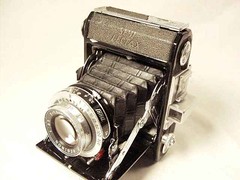 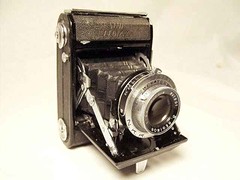 
|
      
|
| Semi Leotax DL, S. Reginon 7.5cm f/3.5 lens no.1801, N.K.K. Wester shutter (B, 1–200), synch pin, early advance key. Pictures courtesy of eBayer Costellochris. (Image rights) |
Documents
The earliest advertisement actually showing the camera is reportedly dated January 1951.[4] The August 1951 advertisement in Asahi Camera gives no price, and mentioned a Reginon or Kominar 75/3.5 lens and a Wester or Copal shutter (B, 1–200).[5]
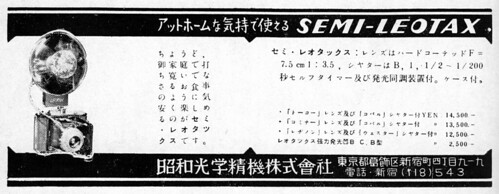
|
| Advertisement in Shashin Kōgyō November 1952. (Image rights) |
The earliest document mentioning the name "Semi Leotax DL" is an advertisement dated May 1952.[6] That in Shashin Kōgyō November 1952, reproduced above, only has the name "Semi Leotax", and lists three lens and shutter combinations:[7]
- Toko 7.5cm f/3.5 lens, Copal shutter, ¥14,500;
- Kominar 7.5cm f/3.5 lens, Copal shutter, ¥13,500;
- Reginon 7.5cm f/3.5 lens, Wester shutter, ¥12,500.
The Toko was supplied by Tōkyō Kōgaku and the Kominar by Nittō Kōgaku. The maker of the Reginon is unknown; it might be Nishida, which made the Wester shutter, and supplied Wester Anastigmat lenses for the early postwar Semi Leotax just before the introduction of the Reginon lens brand.
Advertisements dated January 1953 in Asahi Camera[8] and Shashin Kōgyō[9] mostly convey the same information, and show a picture of the newly released Semi Leotax R (see below).
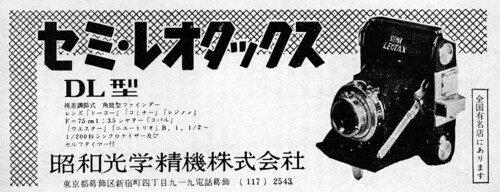
|
| Advertisement in Shashin Kōgyō July 1953. (Image rights) |
The advertisement in Shashin Kōgyō July 1953, reproduced above, mentions a New Trio shutter in addition to the Copal and Wester, and lists the usual Toko, Kominar and Reginon lenses.[10] The maker of the New Trio is unknown, though actual examples show the initials I.J.K., also found on the shutter of a few Tougodo cameras.
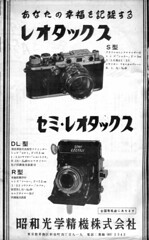  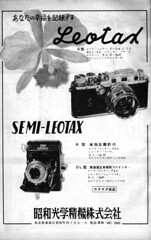
|
| Advertisements in Asahi Camera September to November 1953. (Image rights) |
The version with New Trio shutter is pictured in the advertisements in Asahi Camera dated September to November 1953, reproduced above.[11] The camera has the late type of advance key (see below).
 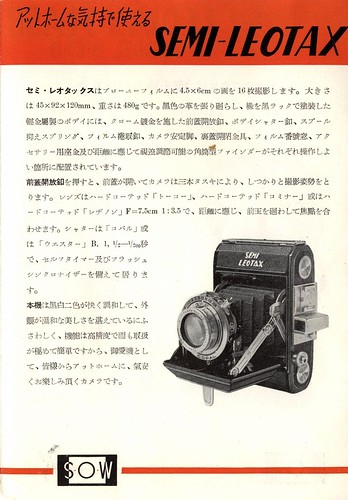
|
| Semi Leotax DL in a leaflet by Shōwa Kōgaku, c.1953. (Image rights) |
The leaflet reproduced above is dated 1953 or perhaps earlier. It shows the Semi Leotax DL along with the Leotax rangefinder camera. The document describes the usual lens and shutter equipment; the New Trio is not mentioned, and the price is not given.
Evolution
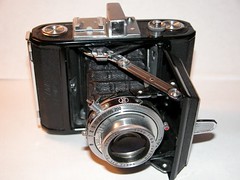 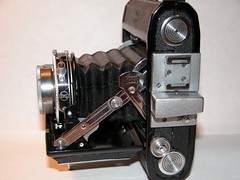 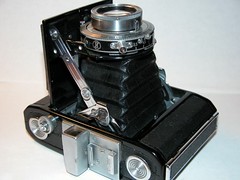
|
  
|
| Semi Leotax DL, Toko 7.5cm f/3.5 lens no.110xxx, Copal shutter (B, 1–200), ASA synch post, early advance key. Pictures courtesy of eBayer Jsahm. (Image rights) |
The Semi Leotax DL evolved little during the production run. The early cameras have the same type of advance key as the previous Semi Leotax.[12] The minimum distance is marked as 3.5 on the viewfinder side, and presumably corresponds to 3.5ft minimum setting on the lens rim.
The lens and shutter combinations observed on those examples are the Reginon and Wester, Toko and Copal, Kominar and Copal. The Wester shutters used at the period have the brand name WESTER at the top of the front plate, the maker's initials N.K.K. on the speed rim, and a single synch pin at the bottom right (as seen from the front). The corresponding Reginon lenses have the name inscribed on a black bezel as C.REGINON (with a red C.) for the earliest ones, and later plain REGINON. They have a five-digit number in the 35xxx to 38xxx range, and the removal of the red C. occurred in the 358xx or 359xx range.[13]

|
| S. Reginon 7.5cm f/3.5 lens no.1801, Wester shutter, synch pin. Picture by eBayer Costellochris. (Image rights) |
The Copal shutters have a white front plate and an ASA synch post at the top right. The Kominar lenses used in the period have a chrome bezel and a five-digit number in the 21xxx to 23xxx range. The Toko lenses have a similar chrome bezel and a six-digit number in the 110xxx to 111xxx range, such as the camera pictured above.
At some point, the minimum distance became 4ft, both on the lens rim and on the viewfinder's parallax compensation mechanism. It seems that this coincides with the switch from the Reginon to the S. Reginon or S-Reginon lens. The name change perhaps indicates that the lens was recomputed, but this is unconfirmed. The sequence of serial numbers was reset, certainly at 1001. The early lenses have the name inscribed as S. REGINON with a dot, such as on the camera pictured at the top of the section, but the engraving was soon changed to S–REGINON with a hyphen.[14]
Immediately after, the camera was fitted with newer Wester shutters, with an ASA synch post and the name WESTER moved to the bottom of the front plate, as on the example pictured below.
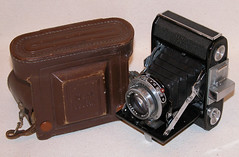 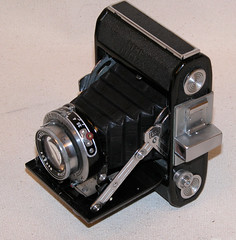 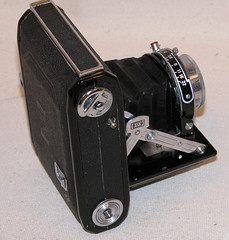
|
| Semi Leotax DL, S-Reginon 7.5cm f/3.5 lens no.4804, N.K.K. Wester shutter (B, 1–200), ASA synch post, early advance key. Pictures courtesy of eBayer Dugwerks. (Image rights) |
The later cameras are distinguished by a newer advance key with sharp edges. These are most common with the S-Reginon lens and Wester shutter, with lens numbers in the 6xxx to 16xxx range.[15] It seems that a few very late ones have a PC socket instead of the ASA bayonet.[16]
Others have an unchanged Copal shutter, with a Kominar lens in the 26xxx range, or a Toko lens in the 113xxx to 114xxx range.[17] Finally, a few cameras have the New Trio shutter, with the brand name NEW TRIO inscribed at the bottom of the front plate, and the initials I.J.K. on the rim (see IJK). It has a synch post at the bottom right, either of the PC type or of another specific type. These shutters are paired with Kominar lenses, whose bezel evolved from a chrome finish in the 26xxx range to a black finish in the 29xxx range.[18]
A few cameras from the late period have EP inside a diamond engraved on the accessory shoe, indicating that they were sold by US Post Exchange facilities to soldiers based in Japan. Very few examples have a five-digit body number engraved on the top plate behind the accessory shoe, in the 10xxx range.[19]
Semi Leotax R, with uncoupled rangefinder
Description
The Semi Leotax R has a top housing containing the viewfinder in the middle, surrounded by the two windows for the uncoupled rangefinder. The rangefinder eyepiece is on the left of the viewfinder and the distance setting knob falls under the right thumb. The distance is read in a small window in the top housing, to the right of the accessory shoe. The top plate is engraved SEMI LEOTAX and Showa Optical Works, Ltd., and a five-digit serial number is engraved in front of the shoe. The rest of the body is similar to the Semi Leotax DL. The lens and shutter combinations are mostly similar to those found on the DL, but most of the Copal shutters have 1/300 top speed (details of the evolution are found below).
Evolution
The rangefinder model was announced and advertised in May 1952 as the Semi Leotax DL II, with Copal shutter and Toko lens.[20] No price is indicated in the advertisement placed that month in Asahi Camera.[21] That in Shashin Kōgyō dated June 1952, reproduced below, shows no model name and gives no price either.[22] It seems that the camera was not yet available for sale at the time.

|
| Advertisement in Shashin Kōgyō June 1952. (Image rights) |
The camera was advertised under its definitive name "Semi Leotax R" from January 1953 onwards.[23] Advertisements placed that month in Asahi Camera and Shashin Kōgyō list the Toko f/3.5 lens and Copal shutter only, available at ¥18,500.[24] Successive advertisements in Shashin Kōgyō, scattered from February to June 1953, list the same characteristics.[25]
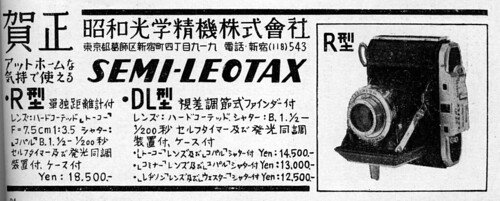
|
| Advertisement in Shashin Kōgyō January 1953. (Image rights) |
  
|
| Advertisements in Shashin Kōgyō February, April and June 1953. (Image rights) |
The picture used in some advertisements is the same as in the leaflet reproduced below, presenting the camera along with the Leotax S. The camera has serial number 10027, and is certainly among the very first produced. The Copal shutter mounted on the early cameras is the same as that found on the DL, with B, 1–200 speeds, a clear-coloured front plate and an ASA synch post. Not many cameras were assembled with that early equipment.[26]
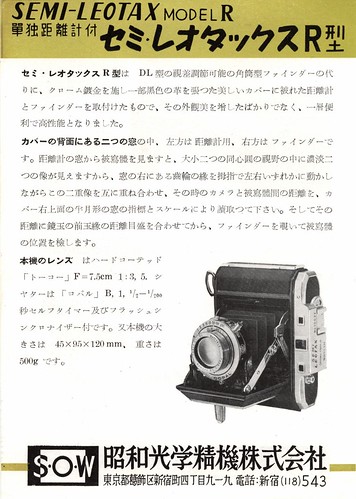
|
| Semi Leotax R in a leaflet by Shōwa Kōgaku, c.1953. (Image rights) |
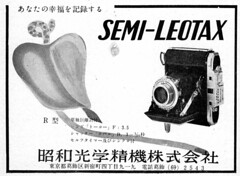
|
| Advertisement in Shashin Kōgyō February 1954. (Image rights) |
The Copal shutter was soon updated with 1/300 top speed and a black shutter plate. This newer version normally has a PC synch socket, though at least one transitional example is known to exist with an ASA synch post.[27] It seems that the Kominar lens option was introduced on the model R simultaneously with the shutter change; the earliest advertisements mentioning this combination are dated August 1953.[28] The production of the model R really gained momentum after that time, and it displaced the DL as Shōwa's main offering for amateur photographers.
A batch of cameras with Kominar lens was produced with a body number in the 11xxx and 12xxx range,[29] then the Toko and Copal combination became the most common again, in the 13xxx to 19xxx range.[30] The advertisement placed in the February 1954 issue of Shashin Kōgyō lists that equipment only, with 1/300 top speed, but shows the same outdated picture of body no.10027.[31]
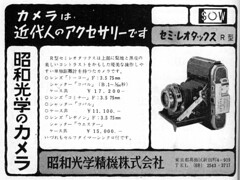
|
| Advertisement in Shashin Kōgyō August 1954. (Image rights) |
After that, the S-Reginon lens and Wester shutter combination was offered on the model R as a cheaper alternative. Actual examples are found with a body number in the 21xxx to 23xxx range, mixed with Toko-equipped cameras.[32] The Wester is similar to that mounted on the late DL. All three lens and shutter combinations were advertised simultaneously in Shashin Kōgyō August 1954 and Asahi Camera September 1954.[33] The prices were lower than the previous year:
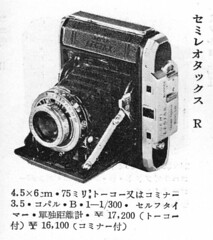
|
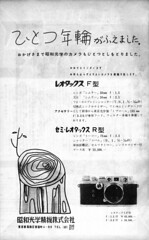
|
| Semi Leotax R in Shashin Kōgyō January 1955. (Image rights) | Advertisement in Asahi Camera January 1955 (text only). (Image rights) |
The late cameras, with a body number in the 24xxx to 30xxx range, have either a Toko or a Kominar lens.[35] One isolated example has been found with the Kominar lens and a New Trio shutter, similar to that mounted on some examples of the Semi Leotax DL.[36] The last mentions of the Semi Leotax R are found in Japanese magazines dated January 1955. A column in Shashin Kōgyō mentions the Toko and Kominar lenses and Copal shutter, at an unchanged price,[37] whereas the advertisement in Asahi Camera lists the Toko version only, at ¥15,500 knock-off price.[38]
Accessories
A flash unit called Leotax High-Power Flash BCB (レオタックス強力発光機BCB型) was offered together with the Semi Leotax, for ¥2,500,[39] later ¥2,000.[40] Its name reminds the contemporary Nikon BCB flash unit, but it is much lighter and probably unrelated; the initials might have a common meaning, which is currently unknown.
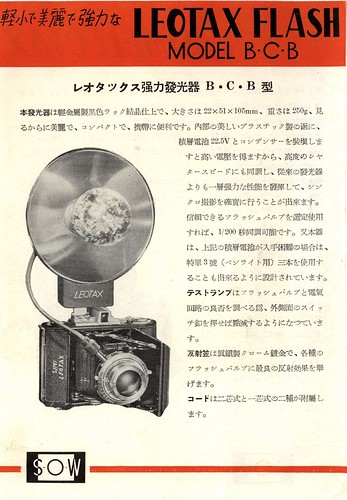
|
| Leotax BCB flash unit in a leaflet by Shōwa Kōgaku, c.1953. (Image rights) |
Notes
- ↑ This is certain for the Toko, a brand name which was used by Tōkyō Kōgaku for three-element designs only. The S-Reginon is reported to have three elements in this page at Orio's Modern Classic Cameras (archived), by someone who disassembled one. The Kominar lens was priced roughly the same, and certainly has three elements too.
- ↑ Advertisement reproduced in Kokusan kamera no rekishi, p.211. The contents of the news column is summarized in the same book, p.374 (item 1036).
- ↑ Might need further confirmation as it was unusual for Olympus to name a lens otherwise then Zuiko.
- ↑ Kokusan kamera no rekishi, p.374.
- ↑ Advertisement reproduced in Kokusan kamera no rekishi, p.211.
- ↑ {{Kokusan}, p.374.
- ↑ Advertisement in Shashin Kōgyō November 1952, p.11.
- ↑ Advertisement reproduced in Kokusan kamera no rekishi, p.212.
- ↑ Advertisement in Shashin Kōgyō January 1953, p.24. The price of the version with Kominar and Copal is mentioned as ¥13,000, perhaps a misprint.
- ↑ Advertisement in Shashin Kōgyō July 1953, p.18.
- ↑ Advertisements in Asahi Camera dated September 1953 (p.3), October 1953 (p.3) and November 1953 (p.3).
- ↑ Examples with Kominar lens in the 21xxx to 23xxx range, with the Toko lens in the 110xxx and 111xxx range, with Reginon lens in the 35xxx to 38xxx range and S-Reginon lens in the 1xxx to 5xxx range.
- ↑ Examples with C.Reginon observed in this page at Minor House and in an online auction. Examples with Reginon observed in various posts [1][2] at Junk Binbō, and in online auctions.
- ↑ Examples pictured in this page at medfmt (archived), and observed in an online auction.
- ↑ Examples pictured in Supuringu kamera de ikou, p.92, and observed in online auctions. The example with lens no.7851 still has the older key, indicating that the transition does not strictly follow the order of the lens numbers.
- ↑ Example with lens number 14xxx pictured in this page of the AJCC. The example with lens no.16266 still has the ASA bayonet.
- ↑ Examples observed in online auctions.
- ↑ Examples observed in online auctions.
- ↑ Example pictured in this page at My Life with Camera (body no.10399), and example observed in an online auction (body no.10747).
- ↑ Kokusan kamera no rekishi, p.374.
- ↑ Advertisement reproduced in Kokusan kamera no rekishi, p.212.
- ↑ Advertisement in Shashin Kōgyō June 1952, p.47.
- ↑ Kokusan kamera no rekishi, p.374. No advertisement is listed between June 1952 and January 1953.
- ↑ Advertisement in Asahi Camera reproduced in Kokusan kamera no rekishi, p.212; advertisement in Shashin Kōgyō January 1953, p.24.
- ↑ Advertisements in Shashin Kōgyō February 1953 (p.82), April 1953 (p.209) and June 1953 (p.305).
- ↑ Examples observed in online auctions: body no.10103 has 1/200 top speed and body no.11395 has 1/300.
- ↑ Example observed in an online auction, body no.11395.
- ↑ Kokusan kamera no rekishi, p.374.
- ↑ Examples observed in online auctions.
- ↑ Examples observed in online auctions, and example pictured in this page at Hayata Camera.
- ↑ Advertisement in Shashin Kōgyō February 1954, p.129.
- ↑ Examples observed in online auctions, and example pictured in this page by Orio.
- ↑ Advertisement in Shashin Kōgyō August 1954, p.129; advertisement in Asahi Camera September 1954 reproduced in Kokusan kamera no rekishi, p.212.
- ↑ The advertisement in Shashin Kōgyō August 1954, p.129, has ¥11,100 instead, but this is clearly a typo.
- ↑ Examples observed in an online auction.
- ↑ Example observed in an online auction.
- ↑ Column in Shashin Kōgyō January 1955, p.66.
- ↑ Advertisement in Asahi Camera January 1955, p.3.
- ↑ Advertisement in Shashin Kōgyō November 1952, p.11; advertisement in Asahi Camera January 1953 reproduced in Kokusan kamera no rekishi, p.212.
- ↑ Advertisement in Nihon Camera September 1954 reproduced in Kokusan kamera no rekishi, p.212.
Bibliography
Original documents
- Asahi Camera. Advertisements by Shōwa Kōgaku Seiki:
- September 1953, p.3;
- October 1953, p.3;
- December 1953, p.3;
- January 1955, p.3.
- Shashin Kōgyō. Advertisements by Shōwa Kōgaku Seiki:
- no.1, June 1952, p.47;
- no.6, November 1952, p.11;
- no.8, January 1953, p.24;
- no.9, February 1953, p.82;
- no.11, April 1953, p.209;
- no.13, June 1953, p.305;
- no.14, July 1953, p.18;
- no.21, February 1954, p.129;
- no.27, August 1954, p.129.
- Shashin Kōgyō no.31, January 1955. "Kokusan kamera sōran" (日本のカメラ全貌・二眼レフカメラ・スプリングカメラ, Panorama of Japanese cameras). P.66.
- Shōwa Kōgaku Seiki. Leotax to Semi Leotax, anata no go-aiyō ni fusawashii kamera (LeotaxとSemi Leotax あなたの御愛用にふさわしいカメラ, Leotax and Semi Leotax, convenient cameras for you). Leaflet published c.1953, date not indicated. Presents the Leotax and Semi Leotax (DL), and has an additional insert on the Leotax S and Semi Leotax R. Document reproduced in this Flickr set by Rebollo_fr.
     
|
| (Image rights) |
- Showa Optical Works (translation for Shōwa Kōgaku Seiki). Instructions for use of the Semi Leotax. User manual in English language, published c.1951. Document reproduced in this Flickr album by Rebollo_fr.
            
|
| (Image rights) |
Recent sources
- Asahi Camera (アサヒカメラ) editorial staff. Shōwa 10–40nen kōkoku ni miru kokusan kamera no rekishi (昭和10–40年広告にみる国産カメラの歴史, Japanese camera history as seen in advertisements, 1935–1965). Tokyo: Asahi Shinbunsha, 1994. ISBN 4-02-330312-7. Items 1037–40. (See also the advertisement and description of item 1036.)
- Kawamata Masataku (川又正卓). Semi Leotax. In Supuringu kamera de ikou: Zen 69 kishu no shōkai to tsukaikata (スプリングカメラでいこう: 全69機種の紹介と使い方, Let's try spring cameras: The use of and actual examples from 69 machines). Tokyo: Shashinkogyo Syuppan-sha, 2004. ISBN 4-87956-072-3. Pp.92–3.
- Lewis, Gordon, ed. The History of the Japanese Camera. Rochester, N.Y.: George Eastman House, International Museum of Photography & Film, 1991. ISBN 0-935398-17-1 (paper), 0-935398-16-3 (hard). P.75 (brief mention only).
- McKeown, James M. and Joan C. McKeown's Price Guide to Antique and Classic Cameras, 12th Edition, 2005-2006. USA, Centennial Photo Service, 2004. ISBN 0-931838-40-1 (hardcover). ISBN 0-931838-41-X (softcover). P.893.
- Sugiyama, Kōichi (杉山浩一); Naoi, Hiroaki (直井浩明); Bullock, John R. The Collector's Guide to Japanese Cameras. 国産カメラ図鑑 (Kokusan kamera zukan). Tokyo: Asahi Sonorama, 1985. ISBN 4-257-03187-5. Items 1319–21.
Links
In English:
- Semi Leotax DL at medfmt (archived)
- Semi Leotax R at Cosmonet's Classic Camera site (archived)
In Japanese:
- Semi Leotax DL at My Life with Camera (archived)
- Semi Leotax DL at Dramatic Camera
- Semi Leotax DL with S-Reginon and Kominar lenses at the AJCC website, the caption mistakenly tells that the DL has auto-stop advance
- Semi Leotax DL at Minor House camera collection
- Semi Leotax DL at kosaka's site
- Semi Leotax R (Copal, Toko) at Hayata Camera Laboratory
- Semi Leotax R at Aya's Camera
